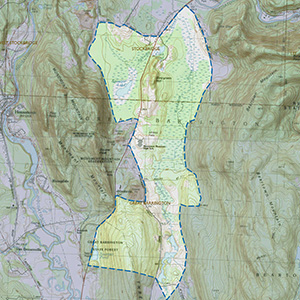Important Bird Area Sites in Massachusetts
Important Bird Area: Konkapot and Agawam Marshes
Site Summary
Nominated By
Mark Lynch
Size
3,000 acres
Towns and Counties
Great Barrington, Stockbridge; Berkshire
Ownership
Mass Wildlife & private
Major Habitats
northern hardwood forest, cultural grassland, cultivated field, emergent fresh-water wetland, palustrine wooded swamp, shrub/scrub wetland, lake/pond, river/stream
Land Use
nature/wildlife conservation, hunting/fishing, agriculture, suburban/urban, undeveloped
Site Description
The IBA is a series of broad cattail and sedge marshes and ponds near the convergence of the Agawam and Konkapot brooks. There are also large areas of Common Reed and many other kinds of emergent vegetation, including Buttonbush and horsetails. The southern end of the area is mostly wooded marshes and small Beaver ponds. The entire area is surrounded by high steep hills. Parts of the marshes contain many dead trees. There is extensive Beaver activity. The land area surrounding the marshes is a combination of mixed forest on steep hills, farms, and private land. Some of the marshes, especially at the southern end, are not even accessible by canoe because of the dense surrounding woody growth. Monument Mountain owned by The Trustees of Reservations is on the western upper edge of the proposed IBA, while Beartown Mountain on state forest land is at the upper eastern edge. The site also includes a section of the Appalachian Trail. A portion of Great Barrington State Forest and Agawam Lake Wildlife Managmenet Area are found around Fountain Pond and areas north of the pond. Fountain Pond next to the marsh system also has been the site of breeding Common Moorhens in recent years, as well as breeding Wood Ducks and sometimes breeding Hooded Mergansers. This pond consists of shallow water and large stands of cattails.
Current Conservation Status
A portion of the IBA is contained within a state park. Purple Loosestrife is a looming threat and would devastate the areas of cattail marshes. Development around the periphery is still a serious problem as this is prime real estate. Development is underway along the marsh edge. Some of the IBA is already preserved as a wildlife management area and state forest. Beaver activity changes the marsh on a yearly basis, and this year the southern end of the proposed IBA area has been drained by the construction of new Beaver dams. In recent years, there has been increased canoe and kayak traffic on the streams. Though normally this would be fairly benign, the areas most visited by the kayaks are the areas that also hold breeding bitterns and moorhens that could be easily disturbed. Birders searching for "year-list" moorhens and rails may also pose a potential disturbance for nesting birds.
Ornithological Significance
Breeding American Bitterns (1 to 3 pairs), Virginia and Sora rails (many), and Common Snipe occur. The IBA is a consistent spot in Massachusetts to find breeding-period Common Moorhens; immature birds are seen at Fountain Pond regularly. Wood Ducks are common breeders throughout, and Hooded Mergansers regularly breed in small numbers. Other common breeders in the marsh are Willow and Alder flycatchers; Swamp Sparrows, Common Yellowthroats; Veery, Wood, and Hermit thrushes; and Red-winged Blackbirds. Species that may breed and have been found during the breeding season at times include the Pied-billed Grebe, Great Blue Heron, and Green Heron. Recently, a King Rail has been found, but it has yet to be proven to breed here. The surrounding forest has decent breeding populations of many wood-warbler species (Canada, Northern and Louisiana waterthrushes, Black-throated Blue and Green, Blackburnian, Yellow-rumped, Chestnut-sided, Yellow, and Ovenbird; vireos (Warbling, Red-eyed, Blue-headed, Yellow-throated); thrushes (Wood, Hermit, Veery); and the Scarlet Tanager, Yellow-bellied Sapsucker, and Pileated Woodpecker. Monument Mountain, has had many records of raptors including in recent years regular reports of Black Vultures from spring through fall. A Black Tern, Black-crowned Night-Heron, and Great Egret, very uncommon to rare in the Berkshires, were all found here recently.
Other Flora or Fauna of Significance
Mammals include Beavers, Muskrats, Red Foxes, Coyotes and Black Bears. Herps found so far include Red-spotted Newt, Green Frogs, Bull Frogs, Spring Peepers, Eastern Painted Turtles and Snapping Turtles. An extensive vertebrate survey of species other than birds has yet to be conducted. The area has many species of butterflies and odonates.
Data Sources
Personal data from M. Lynch accumulated during the breeding season.
M. Lynch, and S. Carroll. Stockbridge: 1/1/98-6/7/02, Great Barrington: 1/1/98-6/7/02. All data submitted to Bird Observer.




